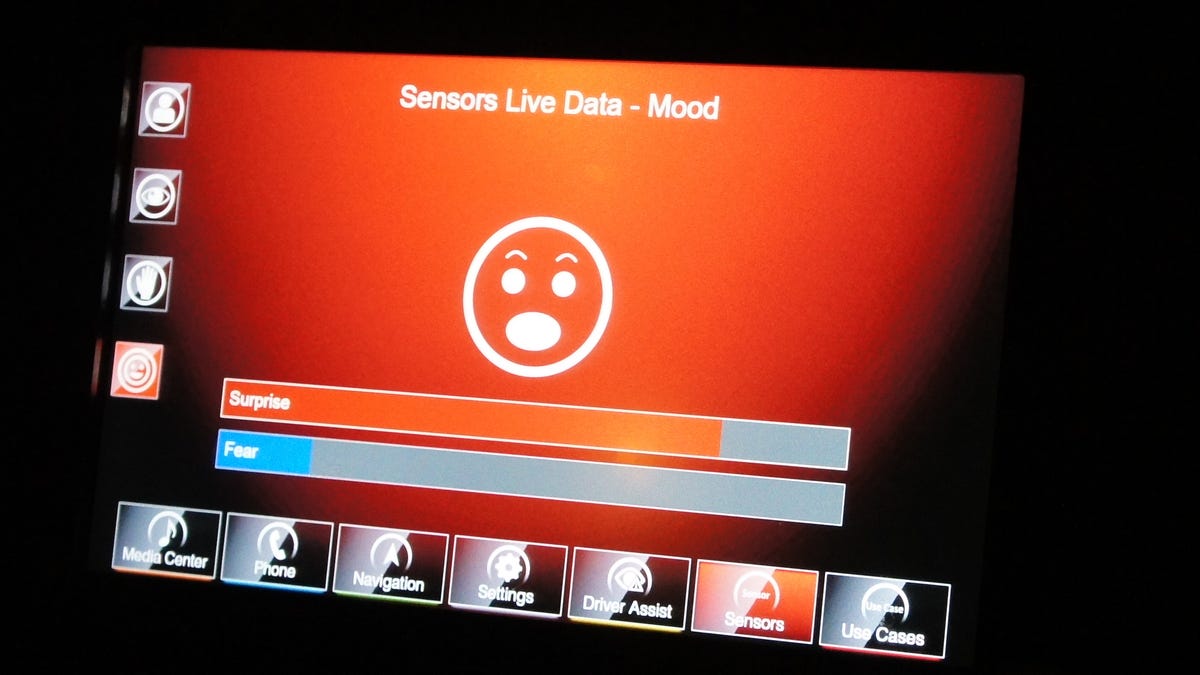FANCI watches your eyes -- and mood -- while you drive
European consortium FANCI brought a concept dashboard to CES 2016, able to track facial movement, gestures, eye movement and even your mood.
As automakers equip cars with ever more sensors to see the outside world, a European consortium has been working on a project called FANCI, which detects where you are looking, and even how you're feeling, in the car.
Safety researchers know that drivers often look away from the road, sometimes at critical moments. A few automakers have already implemented head-tracking systems, that can sound an alert if you spend too much time looking away from the road. Similarly, these systems can detect if you are getting drowsy while driving, and suggest pulling over.
FANCI, which stands for Face and body Analysis Natural Computer Interaction, takes that idea a big step further with a camera and infrared sensors that analyze your face and monitor your eye movement while driving. An additional sensor monitors your hand movements over the console for gesture control.
Showing a demo as part of Harman International's (one of FANCI's partners) CES exhibit, a representative took the wheel of a dashboard prototype. Determining his identity with a facial scan, the dashboard automatically loaded his driving preferences. In a real-life scenario, this personalization could involve changing seat and mirror positions, adjusting ambient lighting, and setting a destination based on a calendar appointment.
Without moving his head, merely changing his gaze to the infotainment display, IR sensors registered his eye movement, raising the brightness of the screen in anticipation of interaction. This eye-gaze monitoring, programmed by a partner company called Tobii, is very precise, to the point where you could focus on individual screen elements. FANCI also integrates gaze detection with gesture control, so you can focus on an individual menu on the screen, then give a thumbs-up or other hand gesture to select it.
As a safety feature, eye-gaze monitoring, in conjunction with external sensors, can also sound an alert or even hit the brakes if a pedestrian is crossing your path and you are looking away from the windshield.
One of the more intriguing features of FANCI is its mood recognition, developed by Swiss company Nviso. This software takes input from the dashboard camera, and determines what emotions the driver is experiencing through facial analysis. At the demonstration booth, the representative expressed happiness, surprise, fear and anger, four of the seven emotions recognized by Nviso. With each successive expression, the a screen showed primary and secondary emotions it had registered.
The concept around mood detection, involves personalization with the FANCI dashboard, so it learns your typical expressions. While driving, it builds up trend analysis from its detection. The dashboard would not necessarily react to momentary surprise, but if its analysis determined you were getting angrier and angrier, for whatever reason, it could trigger some means of preventing road rage, as one example, anywhere from adjusting the stereo levels to changing the car's throttle and braking response.
As another example, a build-up of surprise, among other emotions, might tell the car that you are lost, letting it offer helpful navigation tips.
The FANCI project timeline runs for two years and involves a number of companies and the University of Siena. The demonstration shown at CES represents one year of work, and shows considerable promise. In the next year, the consortium will work towards commercialization. As two goals of the project were to develop a low-cost board with low power consumption, these features could become available in even economy cars within five years.
Check out the rest of CNET's CES 2016 coverage here.


